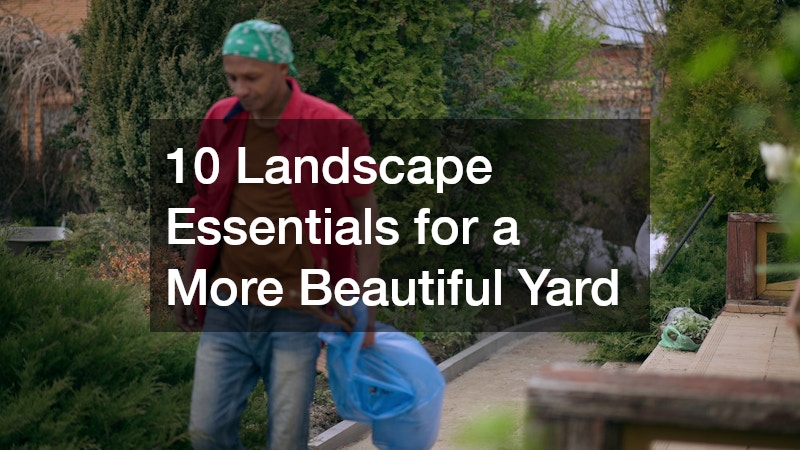Creating a beautiful yard requires more than just mowing the grass and planting a few flowers. It is about bringing together the right elements in a way that enhances curb appeal, improves functionality, and makes the outdoor space more enjoyable. By carefully considering different features and materials, homeowners can transform even the simplest yard into a stunning outdoor retreat. When thinking about landscape essentials, it is important to recognize that each component of a yard contributes to the bigger picture.
Thoughtful planning ensures that the design reflects personal style while still maintaining practicality and long-term ease of upkeep. The right plants, pathways, lighting, and other features work together to create a space that feels cohesive and inviting. Whether the goal is relaxation, entertaining, or simply improving property value, choosing and integrating these elements in a balanced way lays the foundation for a yard that remains beautiful through the seasons.
Another important aspect of designing a yard is thinking about how people will use the space on a daily basis. A yard should not only look visually appealing but also accommodate outdoor activities, relaxation, and social gatherings. Considering pathways, seating, and lighting early in the design process ensures the yard functions well while retaining its aesthetic appeal. By taking a holistic approach, homeowners can make sure every element complements the others, creating a cohesive and enjoyable outdoor environment.
Choosing the Right Plants

Plants set the tone for any outdoor space, bringing color, texture, and life to a yard. Selecting the right varieties involves considering factors like climate, soil type, and available sunlight. A mix of perennials and annuals can keep a garden looking vibrant year-round, while shrubs and trees provide structure and shade. Beyond their visual impact, plants can also improve air quality, support local wildlife, and reduce erosion, making them one of the most fundamental aspects of a thoughtful outdoor design.
For those seeking a practical approach to adding greenery, hydroseeding offers an efficient way to establish a healthy and even lawn. This method applies a mixture of seed, mulch, fertilizer, and water directly onto soil, helping grass take root quickly and effectively. Incorporating this option alongside other planting strategies ensures that the yard thrives, remains easy to maintain, and contributes to the overall harmony of the landscape essentials.
In addition to aesthetics and practicality, plant selection can also support environmental sustainability. Choosing native species or drought-tolerant plants reduces water usage and minimizes maintenance while providing habitat for local wildlife. Incorporating a variety of heights, textures, and bloom times ensures that the yard maintains visual interest throughout the year. When thoughtfully planned, plant arrangements can guide the eye through the space, highlight focal points, and create a sense of balance among all landscape essentials.
Enhancing with Garden Pathways
Pathways are more than just a way to move through a yard; they add structure, guide the eye, and connect different outdoor areas. A well-placed path can create a sense of flow, define spaces like gardens or seating areas, and even make a smaller yard feel more expansive. Materials such as stone, gravel, or brick can complement the overall design while also providing durability and function. Choosing a style that blends with the home’s exterior helps the entire landscape feel cohesive.
One popular option for creating strong and stylish walkways is using pavers. These come in a variety of shapes, sizes, and colors, allowing homeowners to customize paths that fit their personal vision while still providing a sturdy and long-lasting surface. When thoughtfully integrated into a design, pathways built with pavers not only make the yard more functional but also enhance the overall appeal, solidifying their place among essential landscape essentials.
Beyond their functional benefits, pathways can also act as a design statement. Curved walkways can create a sense of mystery and encourage exploration, while straight lines convey order and structure. Strategic use of materials, color, and pattern can transform a simple path into an artful element that enhances the yard’s overall appeal. By integrating pathways thoughtfully, they become more than just routes from one area to another—they serve as an essential component of a cohesive landscape design.
Creating Defined Lawn Edges

Clean, defined edges give a yard a polished look by separating grass, flower beds, and walkways. This subtle detail creates clear boundaries that bring order to the overall design, making the yard appear intentional and well maintained. Edging also makes mowing and trimming easier, prevents grass from spreading into garden areas, and helps highlight different features of the space. When done properly, edging contributes both beauty and practicality, reinforcing the importance of strong design choices.
For a durable and visually appealing option, masonry can be used to create lasting edges that stand out as part of the landscape essentials. Brick, stone, or concrete can be installed in a variety of patterns to complement the yard’s style while providing a strong barrier between areas. This not only increases curb appeal but also ensures that the landscaping maintains its neat, organized appearance over time.
Defined edges can also enhance the longevity of plants and landscaping features. By creating a clear separation between grass and garden beds, you reduce the likelihood of weeds encroaching on planting areas and protect delicate flowers or shrubs from accidental damage during lawn maintenance. Edges also help channel water and nutrients more effectively, promoting healthier growth. When incorporated as part of the landscape essentials, these subtle details elevate the yard’s appearance and functionality.
Installing Outdoor Lighting
Lighting plays a crucial role in extending the usability of a yard into the evening hours. Beyond practicality, it enhances safety by illuminating walkways and discouraging intruders. Strategically placed lights also highlight plants, architectural features, and water elements, adding depth and atmosphere after sunset. With a wide range of options, from solar to low-voltage systems, outdoor lighting can be tailored to suit both aesthetic preferences and functional needs.
When setting up lighting, safety equipment such as a fall arrest system may be needed for more complex or elevated installations. This ensures that fixtures are securely placed while protecting those working on higher areas, like tall trees or rooflines. By combining thoughtful lighting design with the necessary precautions, homeowners can create a warm, inviting outdoor space that truly showcases the landscape essentials day and night. Lighting can also set the mood and enhance nighttime ambiance in ways that transform a yard into a welcoming retreat. By layering different types of lighting—such as path lights, spotlights, and ambient fixtures—homeowners can create a warm and inviting environment that highlights key features.
Adding Functional Seating Areas

A beautiful yard should be as enjoyable as it is visually appealing, and adding seating areas makes outdoor spaces more inviting. Whether it is a patio, deck, or a simple bench under a tree, seating encourages relaxation and creates a place for gathering. It also helps define outdoor “rooms,” allowing the yard to feel like an extension of the home. Comfortable, functional seating adds both style and usability, transforming the yard into a true retreat.
For larger or more intricate projects, working with a masonry contractor can provide customized solutions such as stone patios, fire pits, or built-in seating walls. These additions not only enhance comfort but also add lasting value and beauty to the property. With expert craftsmanship and thoughtful placement, functional seating areas become an integral part of the landscape essentials, balancing both form and function.
Incorporating Water Features
Water features bring movement, sound, and tranquility to any yard, creating a calming atmosphere that appeals to the senses. From small fountains to expansive ponds, these elements can be scaled to fit spaces of all sizes. Beyond aesthetics, water features attract birds and other wildlife, adding to the vibrancy of the outdoor environment. Their reflective surfaces and soothing sounds make them a centerpiece that enhances relaxation and enjoyment.
For homeowners considering larger installations, professional pond excavations can help ensure that water features are both functional and long-lasting. Proper excavation provides a strong foundation, prevents leaks, and supports the integration of pumps or filtration systems. When combined with other landscaping techniques, a well-designed water feature adds depth, beauty, and balance to the overall outdoor design.
Using Mulch for Healthier Soil

Mulch is a simple yet powerful way to improve the appearance and health of a yard. It helps retain soil moisture, regulate temperature, and suppress weeds, all while giving garden beds a finished, uniform look. By choosing the right type of mulch, homeowners can create a natural barrier that enhances plant growth and reduces the need for constant maintenance. Mulch also improves soil quality over time as it breaks down and enriches the ground.
In some cases, sustainable organic materials such as kiln firewood supply leftovers can be repurposed into mulch. This approach not only makes use of available resources but also supports an eco-friendly landscaping practice. By pairing mulch with other landscape essentials, homeowners can boost soil health, create attractive planting areas, and maintain a yard that thrives season after season.
Building Vertical Garden Elements
Vertical gardening is a creative way to maximize space and add visual interest to a yard. Structures like trellises, arbors, and pergolas allow plants to grow upward, creating layers of greenery and texture. Vertical elements can also serve as natural privacy screens, define outdoor rooms, or draw the eye upward, making smaller yards feel more spacious. They are an excellent choice for homeowners who want to blend beauty with practicality.
One way to establish structure for vertical designs is through fence installation, which provides support for climbing plants and helps outline property boundaries. A well-placed fence can become both a functional barrier and a design feature when paired with greenery. Integrating vertical garden elements alongside other landscape essentials ensures a yard feels lush, dynamic, and thoughtfully designed.
Maintaining a Clean and Balanced Layout
A well-designed yard should feel both beautiful and orderly, with every feature contributing to a sense of balance. Over time, clutter, overgrowth, and disorganization can distract from the yard’s overall appeal. Regular upkeep, such as trimming, pruning, and clearing away debris, helps preserve the original design and ensures that the space remains welcoming. Clean lines and open areas also allow the eye to rest, making the yard feel larger and more harmonious.
In some cases, professional services such as graffiti clean up may be necessary when exterior walls, fences, or hardscapes are affected. Restoring these surfaces not only improves appearance but also preserves the integrity of the outdoor space. By combining consistent maintenance with targeted improvements, homeowners can keep their yards fresh and inviting, ensuring that landscape essentials continue to shine.
Blending Seasonal Color and Texture
Changing colors and textures throughout the year brings variety and vibrancy to a yard. By incorporating a mix of plants that bloom in different seasons, homeowners can ensure that their outdoor spaces never feel dull. From spring blossoms to autumn foliage, seasonal variation adds depth and creates a dynamic, ever-changing landscape. Textural diversity through grasses, shrubs, and ground covers also adds richness and dimension to the overall design.
For water-based features, seasonal maintenance such as pond algae treatments can help preserve both the look and health of the environment. Keeping ponds and fountains clear of buildup ensures that they remain a focal point year-round. By combining thoughtful planting with proper care, seasonal adjustments can seamlessly integrate into the landscape, bringing renewed beauty to the yard in every season.
Bringing It All Together
Designing a yard that feels beautiful, functional, and timeless requires careful planning and thoughtful integration of multiple elements. From pathways and seating areas to plants and water features, each detail contributes to the overall atmosphere of the space. A successful landscape balances visual appeal with usability, creating an environment that supports relaxation, gatherings, and lasting enjoyment. Consistent maintenance ensures that the design remains fresh and continues to thrive over the years.
By focusing on landscape essentials such as clean edges, functional features, and seasonal variation, homeowners can transform ordinary yards into inviting outdoor sanctuaries. When each element works together harmoniously, the result is a yard that not only looks stunning but also enhances everyday living. With the right choices and consistent care, any outdoor space can become a lasting source of pride and beauty.



